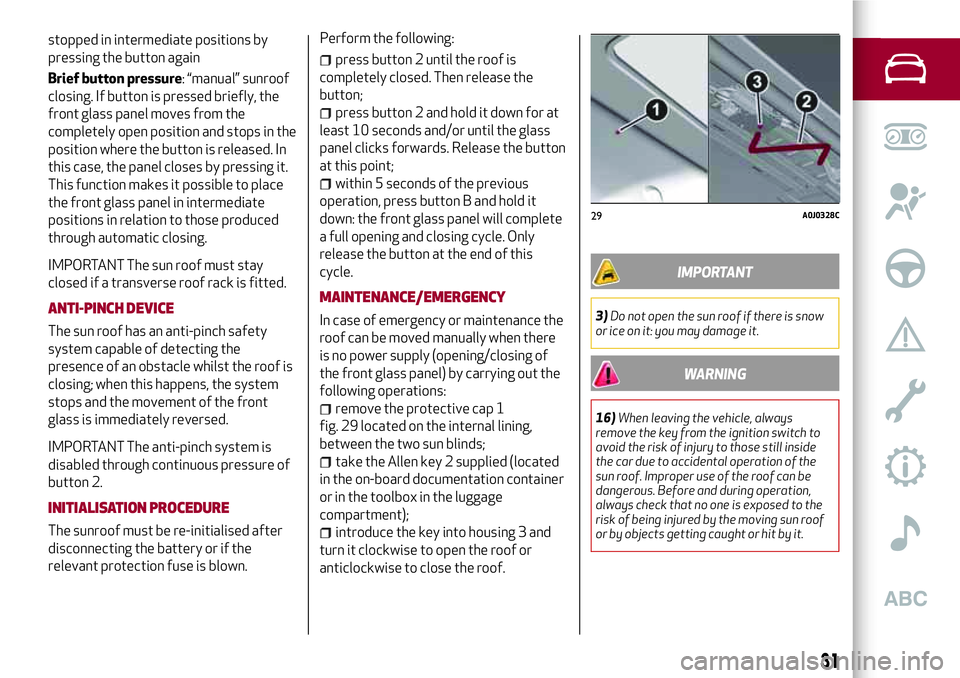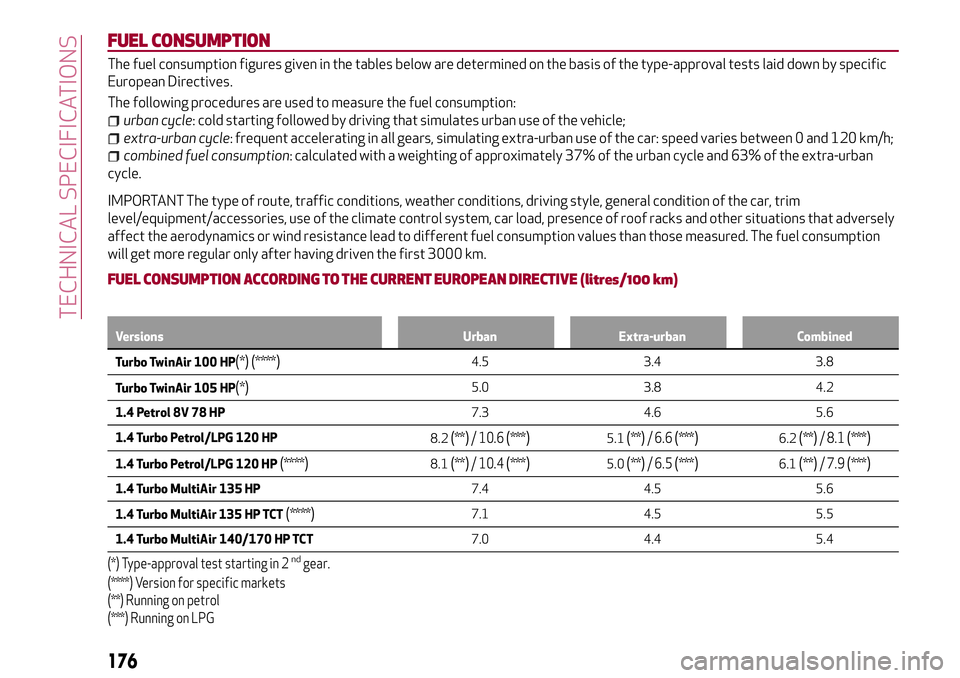roof rack Alfa Romeo MiTo 2018 Owner handbook (in English)
[x] Cancel search | Manufacturer: ALFA ROMEO, Model Year: 2018, Model line: MiTo, Model: Alfa Romeo MiTo 2018Pages: 212, PDF Size: 5.18 MB
Page 33 of 212

stopped in intermediate positions by
pressing the button again
Brief button pressure: “manual” sunroof
closing. If button is pressed briefly, the
front glass panel moves from the
completely open position and stops in the
position where the button is released. In
this case, the panel closes by pressing it.
This function makes it possible to place
the front glass panel in intermediate
positions in relation to those produced
through automatic closing.
IMPORTANT The sun roof must stay
closed if a transverse roof rack is fitted.
ANTI-PINCH DEVICE
The sun roof has an anti-pinch safety
system capable of detecting the
presence of an obstacle whilst the roof is
closing; when this happens, the system
stops and the movement of the front
glass is immediately reversed.
IMPORTANT The anti-pinch system is
disabled through continuous pressure of
button 2.
INITIALISATION PROCEDURE
The sunroof must be re-initialised after
disconnecting the battery or if the
relevant protection fuse is blown.Perform the following:
press button 2 until the roof is
completely closed. Then release the
button;
press button 2 and hold it down for at
least 10 seconds and/or until the glass
panel clicks forwards. Release the button
at this point;
within 5 seconds of the previous
operation, press button B and hold it
down: the front glass panel will complete
a full opening and closing cycle. Only
release the button at the end of this
cycle.
MAINTENANCE/EMERGENCY
In case of emergency or maintenance the
roof can be moved manually when there
is no power supply (opening/closing of
the front glass panel) by carrying out the
following operations:
remove the protective cap 1
fig. 29 located on the internal lining,
between the two sun blinds;
take the Allen key 2 supplied (located
in the on-board documentation container
or in the toolbox in the luggage
compartment);
introduce the key into housing 3 and
turn it clockwise to open the roof or
anticlockwise to close the roof.
IMPORTANT
3)Do not open the sun roof if there is snow
or ice on it: you may damage it.
WARNING
16)When leaving the vehicle, always
remove the key from the ignition switch to
avoid the risk of injury to those still inside
the car due to accidental operation of the
sun roof. Improper use of the roof can be
dangerous. Before and during operation,
always check that no one is exposed to the
risk of being injured by the moving sun roof
or by objects getting caught or hit by it.
29A0J0328C
31
Page 178 of 212

FUEL CONSUMPTION
The fuel consumption figures given in the tables below are determined on the basis of the type-approval tests laid down by specific
European Directives.
The following procedures are used to measure the fuel consumption:
urban cycle: cold starting followed by driving that simulates urban use of the vehicle;
extra-urban cycle: frequent accelerating in all gears, simulating extra-urban use of the car: speed varies between 0 and 120 km/h;
combined fuel consumption: calculated with a weighting of approximately 37% of the urban cycle and 63% of the extra-urban
cycle.
IMPORTANT The type of route, traffic conditions, weather conditions, driving style, general condition of the car, trim
level/equipment/accessories, use of the climate control system, car load, presence of roof racks and other situations that adversely
affect the aerodynamics or wind resistance lead to different fuel consumption values than those measured. The fuel consumption
will get more regular only after having driven the first 3000 km.
FUEL CONSUMPTION ACCORDING TO THE CURRENT EUROPEAN DIRECTIVE (litres/100 km)
Versions Urban Extra-urban Combined
Turbo TwinAir 100 HP(*) (****)4.5 3.4 3.8
Turbo TwinAir 105 HP
(*)5.0 3.8 4.2
1.4 Petrol 8V 78 HP7.3 4.6 5.6
1.4 Turbo Petrol/LPG 120 HP
8.2
(**)/ 10.6(***)5.1(**)/ 6.6(***)6.2(**)/ 8.1(***)
1.4 Turbo Petrol/LPG 120 HP(****)8.1(**)/ 10.4(***)5.0(**)/ 6.5(***)6.1(**)/ 7.9(***)
1.4 Turbo MultiAir 135 HP7.4 4.5 5.6
1.4 Turbo MultiAir 135 HP TCT
(****)7.1 4.5 5.5
1.4 Turbo MultiAir 140/170 HP TCT7.0 4.4 5.4
(*) Type-approval test starting in 2ndgear.
(****) Version for specific markets
(**) Running on petrol
(***) Running on LPG
176
TECHNICAL SPECIFICATIONS
Page 197 of 212

IMPORTANT INFORMATION AND RECOMMENDATIONS
WARNING
INTERIOR FITTINGSDo not travel with the storage compartment open: it may injure the front seat occupants in the event of an accident.
The cigar lighter gets extremely hot. Handle it carefully and make sure that children don’t use it: risk of fire and/or burns.
Do not use the ashtray as a waste paper basket: it may catch fire in contact with cigarette stubs.
ROOF RACK/SKI RACKAfter travelling for a few kilometres, check to ensure that the fixing screws for the attachments are well tightened.
Never exceed the maximum permitted loads (see chapter "Technical specifications").
Distribute the load evenly and pay attention to side winds when driving.
ELECTRIC POWER STEERINGBefore starting any servicing operation, stop the engine and remove the key from the ignition switch to operate the steering lock,
particularly when the wheels do not touch the ground. If this is not possible (for example if the key needs to be turned to MAR or the
engine must be running), remove the main fuse that protects the electric power steering.
INTERIORNever use flammable products, such as petrol ether or rectified petrol to clean the inside of the car. The electrostatic charges
which are generated by rubbing during the cleaning operation may cause a fire.
Do not keep aerosol cans in the car: they might explode. Aerosol cans must not be exposed to a temperature exceeding 50°C.
When the vehicle is exposed to sunlight, the internal temperature can greatly exceed this value.
Page 198 of 212

IMPORTANT
ROOF RACK/SKI RACKFully comply with the regulations in force concerning maximum clearance.
INTERIORNever use alcohol, petrols and derivatives to clean the dashboard and instrument panel lens.